2015轮机英语新版教材添加内容
- 格式:doc
- 大小:76.89 KB
- 文档页数:32
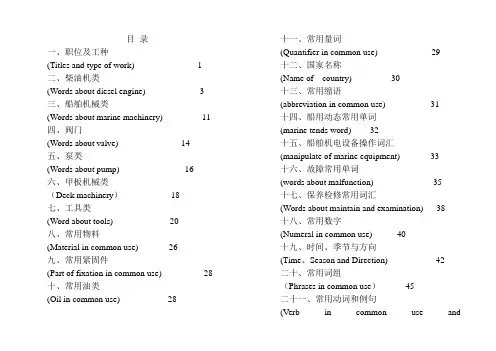
目录一、职位及工种(Titles and type of work) (1)二、柴油机类(Words about diesel engine) (3)三、船舶机械类(Words about marine machinery) (11)四、阀门(Words about valve) (14)五、泵类(Words about pump) (16)六、甲板机械类(Deck machinery) (18)七、工具类(Word about tools) (20)八、常用物料(Material in common use) (26)九、常用紧固件(Part of fixation in common use) (28)十、常用油类(Oil in common use) ··············· 28 十一、常用量词(Quantifier in common use) (29)十二、国家名称(Name of country) (30)十三、常用缩语(abbreviation in common use) (31)十四、船用动态常用单词(marine tends word) (32)十五、船舶机电设备操作词汇(manipulate of marine equipment) (33)十六、故障常用单词(words about malfunction) (35)十七、保养检修常用词汇(Words about maintain and examination) (38)十八、常用数字(Numeral in common use) (40)十九、时间、季节与方向(Time、Season and Direction) (42)二十、常用词组(Phrases in common use) (45)二十一、常用动词和例句(Verb in common use and example) (48)二十二、问候和常用表达语(Greeting and common expression) (67)二十三、主机提交过程用语(Delivery expressions for main engine) (68)二十四、空压机和空气系统用语(Air compressor and Air system) (75)二十五、锅炉提交用语(Delivery expressions for boiler) (77)二十六、锚绞车提交过程用语(Delivery expressions for anchor windlass) (79)二十七、舵机提交过程用语(Steering gear delivering) (87)二十八、付机提交过程用语(Delivery expression for A/E) (91)二十九、救生艇提交过程用语(Delivery expressions for lifeboat) (92)三十、其他提交项目(Delivery expressions for other items) (95)三十一、甲板机械系泊试验(Mooring test for deck machinery) (96)三十二、机舱设备系泊试验(Mooring test for the equipment in E/R) ········98 三十三、谈论故障常用语(Expressions for trouble) (100)三十四、谈论检修常用语(Expressions for overhaul) (101)三十五、谈论试验和检验(Talking about test & check) (103)三十六、谈论技术要求(Talking about technology required) (105)一.职位及工种(Titles and type of work) 1.船长Captain2.大副Chief officer3.二副Second officer4.三副Third officer5.四副Fourth officer6.水手长Boatswain7.水手Sailor & Seaman8.木匠Carpenter9.轮机长Chief engineer10.大管轮Second engineer11.二管轮Third engineer12.三管轮Fourth engineer13.机匠长Chief motorman15.机匠Fitter16.加油工Oil man17.大电Chief electrician18.电工Electrician19.车间主任Workshop director20.工长Section chief21.班长Fore man22.钳工Fitter23.主管工程师Engineer in charge24.机务&船东Superintendent &Super &Owner25.助理工程师Assistant engineer26.验船师(机)Register27.验船师(船)Surveyor28.油漆工Painter29.焊工Welder30.大橱Chief cook31.物料员Store keeper32.加油工Oiler33.机工Mechanic 34.甲板员Deck man35.电线工Wireman36.外包工Laborer37.铸工Molder38.管子工Pipe fitter39.起重工Crane operator二、柴油机类(Words about diesel engine)1.主机Main engine2.二冲程柴油机Two-stroke diesel engine 3.四冲程柴油机Fore-stroke diesel engine 4.高速柴油机High speed diesel engine 5.中速柴油机Middle speed diesel engine 6.低速柴油机Low speed diesel engine 7.气缸盖(缸头) Cylinder head8.安全阀Safety valve9.释放阀Relief valve10.示功阀Indicator valve11.示功考克Indicator cock12.空气起动阀Air starting valve13.起动空气分配器Air starting distributor 14.油头(燃油喷射器) Fuel injector15.排气阀Exhaust valve16.气缸套Cylinder liner17.冷却水套Cooling water jacket 18.气缸注油器Cylinder lubricator19.活塞Piston20.活塞头Piston crown21.活塞裙Piston skirt22.活塞销Piston gudgeon pin24.活塞杆Piston rod25.活塞环Piston ring26.活塞环槽Piston ring groove27.压缩环(气环) Compression ring 28.刮油环(油环) Oil scraper ring29.减磨令Wear ring (copper ring) 30.伸缩管(水拉管) Telescopic pipe31.活塞冷却空间Piston cooling space 32.填料箱(函) Stuffing box33.填料箱密封环Sealing ring for Stuffing box 34.填料箱压缩环Pressure ring for Stuffing box 35.填料箱刮油环Scraper ring for Stuffing box 36.扫气箱Scavenging receiver 37.扫气口Scavenging port 38.排气口Exhaust port 39.十字头Cross head40.十字头销Crosshead pin 41.十字头轴承Crosshead bearing 42.十字头滑块Crosshead slipper 43.滑块Guide shoe44.十字头导板Crosshead guide plate 45.连杆Connecting rod 46.连杆大端轴承Bid end bearing 47.连杆小端轴承Small end bearing 48.曲柄轴承Crank bearing 49.曲柄销Crank pin50.曲轴Crank shaft51.曲轴颈Crank journal 52.曲柄臂Crank web53.拐档差Crank deflection 54.主轴承Main bearing 55.主轴颈Main journal56.轴承瓦Bearing bush 57.上轴瓦Upper bearing bush58.上轴瓦Upper half59.下轴瓦Lower bearing bush60.下轴瓦Lower half61.推力轴承Thrust bearing62.推力块Thrust pad63.推力盘Thrust disc64.推力轴Thrust shaft65.底座Bed plate66.机架Frame67.曲柄箱Crank case68.曲柄箱导门Crank case door69.曲柄箱防爆门Explosion-proof Crank case. 70.定时齿轮Timing gear71.飞轮Flying wheel72.凸轮Cam73.凸轮轴Cam shaft74.喷油凸轮Fuel injection cam75.链条Chain76.链条轮Chain wheel77.链条箱Chain box78.推杆Push rod 79.摇臂Rocker arm80.排气阀Exhaust valve81.吸气阀Suction valve82.排气总管Exhaust manifold83.进气总管Air inlet manifold84.高压燃油管High pressure fuel pipe 85.活塞冷却水管Piston cooling water pipe 86.法兰Flange87.贯穿螺栓Tie bolt (tie rod)88.端盖Side cover89.滑油泵Lubricating oil pump90.燃油泵Fuel oil pump91.滑油泵齿轮Gear for lubricating oil pump 92.燃油泵齿轮Gear for fuel oil pump 93.叶轮Impeller94.柱塞Plunger95.导杆Guide rod96.导套Sleeve97.滚动轴承Ball bearing98.滑动轴承Sliding bearing99.推力滚动轴承Thrust ball bearing100.推力面Thrust surface (thrust side) 101.盘车机Turning gear102.增压器Turbocharger103.涡轮机(透平) Turbine104.涡轮Turbine wheel105.涡轮叶片Turbine blade106.喷嘴Nozzle107.废气叶轮Exhaust impeller 108.废气叶轮片Exhaust blade109.废气端Exhaust side110.透平端Turbine side111.转子轴Rotor shaft112.油泵L.O. pump113.换向装置Reversing device 114.换向伺服期Reversing servomotor 115.压气机(鼓风机) Blower116.膨胀接Expansion joint 117.调速器governor118.飞重Flying weight119.补偿阀Compensate valve 120.针阀Needle valve 121.开口销Cotter pin122.轴封Shaft seal123.机械密封Machinery seal 124.配电盘Switchboard125.应急配电盘Emergency switchboard 126.应急发电机Emergency generator 127.滤器Filter128.细滤器Filter129.粗滤器Strainer130.滑油滤器L.O. filter131.燃油滤器 F.O. filter132.空气消音器Air intake silencer 132.空气滤器Air intake filter 133.空气瓶Air bottle (receiver) 134.分油机Separator135.油水分离器Water-oil separator 136.净油机Purifier137.燃油净化器 F.O. purifier 138.二氧化碳CO2139.二氧化碳瓶CO2 bottle 140.正时齿轮Timing gear141.导向棒装置Guide bar142.注油器驱动Lubricator driver 143.链条张紧装置Chain tightener144.凸轮轴传动轮Chain wheel on cam shaft 145.中间链链传动轮Intermediate chain wheel 146.注油器驱动装置Lubricator drive 147.链条张紧装置Chain tightener148.滚筒导座Roller guide housing 149.应急操纵台Emergency console 150.力矩平衡器Moment compensator 151.主启动阀Main starting valve 152.启动空气分配器Starting air distributor 153.喷油器Fuel valve154.扫气系统Scavenge air system 155.安全帽Safety cap156.机座Bed plate157.轴向振动减振器Axial vibration damper 158.贯穿螺栓Arrangement of stay bolt 159.示功器驱动装置Indicator driver 160.端罩End shields161.气缸架Cylinder frame 162.气阀传动装置Valve operating device 163.摇臂润滑油泵Rocker arm lubricating oil pump164.摇臂润滑油柜Rocker arm lubricating tank 165.摇臂润滑滤器Rocker arm lubricating filter 三、船舶机械类(Words about marine machinery) 1.船用锅炉Marine boiler2.废气锅炉Exhaust boiler3.辅锅炉Donkey boiler4.组合式锅炉Combined boiler5.火管Fire tube6.给水管Feed pipe7.炉膛Furnace8.炉墙Furnace wall9.火侧Fire side10.水侧Water side11.燃烧器Oil burner12.安全阀Safety valve13.上排污Upper drain14.下排污Lower drain15.锅炉皮阀Mounting valve16.水位计Water level gauge17.压力表Pressure gauge18.主汽门Main steam valve19.玻璃管Glass tube20.空调装置Air-conditioning plant21.制冷装置Refrigerating plant22.冰机Fridge. Machine23.空气压缩机Air compressor24.造水机Fresh water generator 25.板式冷却器Plate type cooler26.机舱天车Engine room crane27.天车导轨Crane rail28.电磁阀Solenoid valve29.舵机Steering gear30.舵承Rudder bearing carrier 31.液压缸Hydraulic cylinder32.废气涡轮增压器Exhaust gas turbocharger 33.弹簧阀Spring loaded valve 34.冷凝器Condenser35.分油器Oil separator36.轴带发电机Shaft generator 37.焚烧炉Oil burner38.分油机Separator39.分离筒Separator bowl40.配水盘装置Paring disc device 41.转数计Revolution counter 42.控制阀Control valve43.辅机Auxiliary machinery 44.制冷装置Refrigerating plant 45.海水淡化装置Sea water desalting plant 46.热交换器Heat exchanger 47.船用气瓶Marine air bottle 48.冷风机Cooler unit49.防水风门Fire damper50.气密挡板Gas tight damper 51.排气风机Exhaust fan52.舱室通风机Cabin fan53.机舱通风机Engine room fan 54.应急鼓风机Emergency blower四、阀门(Words about valve)1.吸气阀Suction valve2.排气阀Exhaust valve3.控制阀Control valve 4.导阀Pilot valve 5.单向阀Non-return valve 6.口琴阀Flap valve 7.调节阀Regulating valve 8.液压阀Hydraulic valve 9.膨胀阀Expansion valve 10.给水阀Feed valve 11.排水阀Discharge valve 12.截止阀Stop valve 13.吹泄阀Blow-off valve 14.空气阀Air valve 15.泄放阀Drain valve 16.止回阀Check valve 17.海底阀Sea valve 18.回流阀Retune valve 19.节流阀Throttle valve 20.进气阀Inlet valve 21.出气阀Outlet valve 22.热力阀Thermal valve 23.中央阀Center valve 24.单向阀One way valve25.二通阀Two way valve26.三通阀Triple valve27.旁通阀By-pass valve28.换向阀Change-over valve 29.减压阀Pressure-reducing valve 30.溢流阀Overflow valve31.自闭阀Self-locking valve 32.针阀Needle valve33.平衡阀Balance valve34.循环阀Circulation valve 35.主阀Main valve36.滑阀Slide valve37.蝶阀Butter-fly valve38.截止阀Shut-off valve39.闸板阀Gate valve40.通海阀Sea suction valve 41.吹除阀Sea chest cleaning valve 42.防浪阀Storm valve43.舱壁阀Bulkhead valve44.快关阀Emergency shut off valve45.呼吸阀Breather valve 五、泵类(Words about pump) 1.电动泵Motor-driven pump 2.柱塞泵Plunger pump 3.叶片泵Vane pump4.回转泵Rotary pump 5.齿轮泵Gear pump6.往复泵Reciprocating pump 7.离心泵Centrifugal pump 1.电动泵Motor-driven pump 2.柱塞泵Plunger pump 3.叶片泵Vane pump4.回转泵Rotary pump 5.齿轮泵Gear pump6.往复泵Reciprocating pump 7.离心泵Centrifugal pump 8.真空泵Vacuum pump 9.螺杆泵Screw pump 10.喷射泵Ejector pump 11.冷却泵Cooling pump 12.淡水泵Fresh water pump 13.海水泵Sea water pump 14.给水泵Feed water pump 15.循环泵Circulating pump 16.锅炉给水泵Boiler feed pump 17.卫生水泵Sanitary pump 18.压载泵Ballast pump 19.舱底泵Bilge pump 20.污水泵Sewage pump 21.燃油泵Fuel pump22.高压油泵High pressure pump 23.底压油泵Low pressure pump 24.驳运泵Transfer pump 25.增压泵Booster pump 26.消防泵Fire pump27.通用泵G.S. pump28.旋涡泵Regenerative 29.蜗壳泵V olute pump 30.导叶泵Diffuser pump 31.单联泵Simplex pump 32.双联泵Duplex pump 33.多联泵Multiplex pump34.活塞泵Piston pump35.减摇泵Anti-roll pump 36.总用泵General service pump 37.应急消防泵Emergency fire pump 38.扫舱泵Stripping pump 39.货油泵Cargo oil pump 40.滑油泵Lubricating oil pump 六、甲板机械类(Deck machinery)1.锚机Windlass2.锚机轴Windlass shaft3.刹车带Brake lining4.离合器Clutch5.锚链轮Anchor Chain wheel 6.轴承瓦Bearing bush7.轴承盖Bearing cover8.绞揽机Capstan9.系揽绞车Mooring winch 10.卷缆车Reel11.钢丝绳Wire rope12.卡环Shackle13.缆绳Mooring rope 14.滑轮Block15.刹车装置Brake device 16.制链器Anchor chain stopper 17.舱盖滚轮Hatch cover wheel 18.舱盖铰链Hatch cover hinge 19.液压油缸Hydraulic jack 20.起货机Cargo winch 21.可令吊Crane22.生活吊Accommodation crane 23.吊杆Derrick boom 24.桅杆Mast25.救生艇Lifeboat26.艇架Davit27.艇机Lifeboat capstan 28.救生筏Life raft29.救生衣Life jacket七、工具类(Word about tools) 1.车床Lathe2.刨床Planing machine 3.钻床Drill machine 4.砂轮机Grinding machine5.磨床Grinder6.铣床Milling machine 7.镗床Boring machine 8.手锤Engineer’s hammer 9.冲击板手Impact wrench 10.板手Spanner11.活络板手Screw spanner 12.梅花板手Ring spanner 13.呆扳手Open spanner 15.套筒板手Socket spanner 16.管子钳Pipe spanner 17.螺丝刀Screw driver 18.钢丝钳Wire pliers 19.尖嘴钳Long nose pliers 20.钢锯Hack saw21.剪刀Scissors22.手电筒Torch23.扁铲(凿子) Chisel24.锉刀File25.丝攻Thread tap 26.板牙Thread die 27.绞刀Reamer28.刮刀Scraper29.油石Oil stone30.拔子(拉马) Puller31.沙布Emery cloth32.破布Rag33.卷尺Measuring tape34.空心冲Hole punch35.样冲Joint punch36.油壶Oil gun37.牛油枪Grease gun38.手电钻Handle drill39.钻头Drill40.液压千斤Hydraulic jack.41.塞尺Feeler gauge42.游标卡尺Vernier caliper43.外卡尺Outside calipers 44.内卡尺Inside calipers45.螺纹量规Screw gauge46.桥规Bridge gauge47.电焊机Electrode welding machine48.气焊机Gas welding machine 49.电焊钳Electric welding pliers 50.气割枪Cutting touch51.电焊条Electric soldering iron 52.电工刀Electrician knife 53.电笔Test pen54.剥线钳Wire stripping pliers 55.圆规Compass56.量表Gauge57.拐档表Crank deflection gauge 58.深度规Depth gauge59.千分表Micrometer gauge 60.台虎钳Table vice61.柴油Diesel oil62.滑油Lubricating oil 63.液压油Hydraulic oil64.重油Heavy oil65.燃油Fuel oil66.黄油Grease67.螺栓Bolt68.螺帽Nut 69.垫片Washer70.研磨沙Grinding sand71.研磨膏Grinding paste72.石棉板Asbestos plate73.青壳纸Fish paper74.盘根Packing75.细钢丝Thin steel wire76.密封圈Rubber seal ring77.塑料管Plastic pipe78.胶皮管Rubber hose79.电灯泡Electric bulb80.工作灯Working lamp81.插头Electric plug82.插座Electric socket.93.喷砂机Sand blaster outfit94.空气马达Air motor95.油柜清洁器Tank cleaning machine96.高压冲水机High pressure hose for hydraulic 97.真空泵Vacuum pump98.套筒扳手组Socket wrench set99.深头套筒Deep socket wrench100.套筒扳手Box wrench101.单开口扳手Single open end wrench 102.双开口扳手Double open end wrench 103.转矩扳手Torque wrench104.电动机扳手Motor wrench105.侧剪钳Slide cutting plier106.活节钳Combination plier107.可调快速扳手Speed wrench108.螺丝起子Screwdriver109.偏向螺丝起子Offset screw110.六角螺帽起子组Hexagon nut drivers set 111.手摇钻Straight hand drill112.手工锯Hacksaw frame113.锯片Hacksaw blade114.砂纸Silicon paper115.手拉葫芦Chain block116.高压管High pressure hose 117.液压千金顶Hydraulic jack118.锤子Hammer119.平錾Cold chisel120.活动扳手Adjustable wrench 121.螺丝刀Screwdriver122.侧剪铗Side cutting hipper123.螺栓剪Cable cutter124.敲击管钳Rap wrench125.砂轮Grinding wheel126.老虎钳Utility vise127.直梯Straight ladder128.踏梯Step ladder129.平台推车Platform trunk130.搬平车Gas cylinder carrier 131.给油机Grease lubricator132.强力油泵Heavy duty pump oiler 133.油壶Oil jag134.麻花钻Twist drill135.绞刀Pin reamer136.旋转中心钻Rolling center137.外径测微计Outside micrometer with counter 138.六折式尺Six-folding rule139.弹性带尺Convex rule140.不锈钢直尺Stainless steel straight rule 141.平面规Surface gauge142.平行直角定规Precision flat try square 143.温度计Thermometer八、常用物料(Material in common use) 1.阀研磨剂valve grinding compound 2.电焊条steel electrode3.气焊条Steel welding wire4.细钢丝绳Seizing wire5.刚焊条Steel welding rod6.紫铜管Copper tube7.乙炔气瓶Acetylene cylinder8.木屑Saw dust9.水泥Cement10.石灰Lime11.帆布手套Canvas glove12.垫片Gasket.13.氧气瓶Oxygen cylinder14.抹布Rag15.垫隙片Shim16.电线Wire17.电缆Electric cylinder18.电池Rag 19.灯泡Bulb20.胶布Insulating tape21.插头Plug22.插座Socket23.保险丝Fuse24.不锈钢Stainless steel25.铸铁Cast iron26.黄铜Brass27.青铜Bronze28.铝合金Aluminium alloy29.橡胶Rubber30.石棉Asbestus31.低碳钢Soft steel32.高碳钢High-carbon steel33.合金钢Alloy steel34.木材Wood35.塑料Plastic36.球墨铸铁Nodular iron九、常用紧固件(Part of fixation in common use) 1.螺栓Bolt2.螺丝Screw3.螺母Nut4.方头螺栓Sq head bolt5.埋头螺栓Counter sunk head screw 6.套筒螺栓Socket head bolt7.定位螺栓Set screw8.十字接头Cross9.锥形销Taper pin10.锁紧螺母Lock nut11.六角头螺栓Hex head bolt十、常用油类(Oil in common use)1.汽油Gas oil2.煤油Kerosene3.润滑油Lubricating oil4.汽缸油Cylinder oil5.压缩机油Compressor oil6.齿轮油Gear oil7.机油Motor oil8.凡士林Vaseline9.燃油Fuel oil10.油脂Grease11.柴油Diesel oil 十一、常用量词(Quantifier in common use) 1.件,只,个Piece2.条,张,片Sheet3.双Pair4.套,组,副Set.5.盒Box6.箱Case7.瓶Bottle8.米Meter9.厘米Centimeter10.毫米Millimeter11.公斤Kilogram12.克Gram13.公升Liter14.平方Square15.袋Bag16.码Yard17.吨Ton18.磅Pound19.加仑Gallon20.立方Cubic十二、国家名称(Name of country) 1.中国China2.美国American3.日本Japan4.英国Britain5.法国France6.德国German7.韩国South Korea8.希腊Greece9.泰国Thailand10.印度India11.挪威Norway12.俄罗斯Russia13.新加坡Singapore14.澳大利亚Australia15.伊朗Iran16.丹麦Denmark17.加拿大Canada18.丹麦Denmark19.芬兰Finland20.巴基斯坦Pakistan 21.意大利Italy十三、常用缩语(abbreviation in common use) 1.主机M/E2.付机A/E3.阀V/V4.泵P/P5.备车St/by6.完车 F.W.E.7.前进三FAHD8.微速后退 D.S.Ast9.前进二H.Ahd10.高压H.P.11.低压L.P.12.重油/柴油H.O./D.O.13.前后F/A14.左舷P: port15.无人机舱UMS16.自动Auto17.气缸Cyl18.燃油柜 19.滑油柜20.沉淀柜.21.排出Disc22.吸入Suct23.柴油柜 十四、船用动态常用单词(marine tends word) 1.停靠Alongside2.接近Approach3.停泊Berth4.浮筒Buoy5.码头Pier6.港口Port7.移泊Shift8.航次V oyage9.试验Try10.值班Watch11.航行Sail十五、船舶机电设备操作词汇(manipulate of marine equipment)1.调整Adjust2.压载Ballast3.转换Change over 4.清洁Clean 5.联接Connect 6.排放压载Deballast 7.放残水Drain 8.卸载Off9.油漆Paint 10.接通Put on 11.吹灰Soot blown 12.开始Start 13.顶端Top 14.洗Wash 15.吹Blow 16.检查Check 17.铲Chip 18.断开Cut out 19.排放Discharge 20.除垢Descale 21.检验Examine 22.受载On(load) 23.用泵排出Pump out 24.调整Set25.停止Stop26.调驳Transfer27.加满Top up十六、故障常用单词(words about malfunction) 1.失常的Abnormal2.烧坏Burn3.堵塞Clog4.裂缝Crack5.变形Deform6.毁坏Destroy7.磨损Wear8.出故障In trouble9.敲击Knock10.松开Loose11.不对中Misalign12.不足的Insufficient13.失灵Out of order14.过载Overload15.过度磨损Over-worn16.尺寸过大Oversized17.尺寸过小Under-sized 18.振动Vibrate 19.不平的Uneven 20.不准确Inaccurate 21.全船断电Black out 22.出故障Fail23.关掉Shut off 24.弯曲Bend 25.停车Break drown 26.腐蚀Corrode 27.腐蚀的Corrosive 28.损坏Damage 29.有毛病的Faulty 30.有缺陷的Defective 31.破裂Fracture 32.卡住Jam 33.漏泄Leak 34.漏泄的Leaky 35.融化Melt 36.噪声Noise 37.过热Overheat 38.咬住Seize39.紧的Tight40.松的Loosen41.发现Find42.停止Stop43.脏的Dirty44.油污的greasy45.失效的ineffective 46.椭圆形的oval47.点不着火misfire48.接错misjoin49.放错misplace50.老化perish51.麻点pit52.凸起ridge53.划伤score54.拉痕scuff十七、保养检修常用词汇(Words about maintain and examination) 1.卡死Blind2.用卡钳量Caliper3.关闭Close 4.解体Disassemble 5.安装Fix6.组装Box up 7.检验Check8.拆卸Dismantle 9.装配Fit10.紧固Fasten 11.测量Gauge 12.安装Install 13.测量Measure 14.打开Open 15.上油漆Paint 16.换新Renew 17.上紧Tighten 18.洗Wash 19.涂油脂Grease 20.松开Loosen 21.加油Oil22.检修Overhaul 23.重新组装Reassemble 24.测取读数Take reading25.拧开螺栓Unbolt26.抽出Withdraw十八、常用数字(Numeral in common use) 一One二Two三Three四Four五Five六Six七Seven八Eight九Nine十Ten十一Eleven十二Twelve十三Thirteen十四Fourteen十五Fifteen十六Sixteen十七Seventeen十八Eighteen 十九Nineteen二十Twenty三十Thirty四十Forty五十Fifty六十Sixty七十Seventy八十Eighty九十Ninety百Hundred千Thousand万Ten thousand 百万Million第一First第二Second第三Third第四Fourth第五Fifth第六Sixth第七Seventh第八Eighth第九Ninth第十Tenth第十一Eleventh第十二Twelfth第二十Twentieth十九、时间、季节与方向(Time、Season and Direction) 1.星期一Monday2.星期二Tuesday3.星期三Wednesday 4.星期四Thursday5.星期五Friday6.星期六Saturday7.星期日Sunday8.春季Spring9.夏季Summer10.秋季Autumn11.冬季Winter12.一月January13.二月February14.三月March 15.四月April 16.五月May 17.六月June 18.七月July 19.八月August 20.九月September 21.十月October 22.十一月November 23.十二月December 24.小时Hour 25.分钟Minute 26.秒Second 27.月Month 28.天Day 29.夜Night 30.周Week 31.早晨、上午Morning 32.下午Afternoon 33.傍晚Evening 34.正午Noon 35.今天Today36.昨天Yesterday37.明天Tomorrow38.前天The day before yesterday 39.后天The day after tomorrow 40.本周This week41.上周Last week42.下周Next week43.九月十日Sep.10th44.去年Last year45.明年Next year46.上周二Last Tuesday47.下周一Next Monday48.东East49.西West50.南South51.北North52.西北Northwest53.东北Northeast54.东南Southeast55.西南Southwest56.世纪Century 二十、常用词组(Phrases in common use)1.发现已无法修复found beyond repair2.发现尺寸过大found over-sized3.发现反应缓慢found slow function4.发现不正常found out of order5.发现不合标准found not up to standard 6.发现不准确found inaccurate7.发现失去作用found out of function 8.发现轧住found seized9.发现过热found overheated10.发现过度磨损found excessive wear 11.发现过度磨掉found worn out12.发现有一点倾斜found a little bit inclined 13.发现不正常found abnormal14.发现因过热而损坏found destroyed by overheating15.发现龟裂found chapped16.发现塌陷found collapsed17.发现运转失灵found out of operation 18.发现呈椭圆形found oval19.发现拉痕found scored20.发现拉毛found scuffed21.发现变形found deformed22.发现松动found loose23.发现油污found greasy24.发现肮脏found dirty25.发现咬住found stuck26.发现挤压found squeezed27.发现弯曲found bent28.发现故障found faulty29.发现损坏found damaged30.发现破碎成片found broken to pieces 31.发现部分剥离found partly detached 32.发现部分堵塞found partly choked 33.发现剧烈震动found violent vibration 34.发现烧坏found burnt35.发现断裂found fractured36.发现接地found earthed37.发现敲缸found knocking38.发现溶化found melted away 39.发现泄漏found leaking (found leaky) 40.发现冻结found stuck fast by icing 41.发现锈蚀found rusty42.发现失效found ineffective 43.发现故障found out of order 44.发现结霜found frosted 45.发现丢失found lost46.发现出故障found in trouble 47.发现失灵found out of order 48.发现失灵found out of action 49.发现不一致found out of operation 50.发现错位found out of place二十一、常用动词和例句(Verb in common use and example)1.借borrow我要向你借这份图纸I want to borrow the drawing from you.我可以向你借这个手锤吗?May I borrow the hammer from you?2.裂break阀杆断裂了The valve spindle is broken.滚动轴承断裂成碎片了The ball bearing are broken to pieces.3.加强build up叶轮应该堆焊The impeller should be built up by welding.4.烧burn电动机烧了The motor is burnt.5.进行carry out应进行负载试验The load test should be carried out.6.吹blow管子必须用压缩空气吹清The pipe should be blown with compressed air. 7.铸cast按原样铸造一个Cast one piece as per sample. 8.引起cause损坏是有剧烈振动引起的The damage was caused by violent vibration. 9.倒角chamfer油槽须倒角Oil groove is to be chamfered.法兰切削后须倒角The flange should be chamfered after being machined. 10.换掉change把它们换掉,否则我拒绝验收Have them changed, otherwise I refuse to accept them.11.龟裂chap轴瓦上的白合金龟裂了The white metal on the bearing bush is chapped. 12.核查check用桥规核查主轴承Check the main bearing with bridge gauge.修理前后要核查拐档差Check the crankshaft deflection before and after repair.13.清洁clean装前须清洁Clean it before fit back.14.阻塞clog燃油滤器阻塞了The fuel filter is clogged. 15.涂漆coat用红丹涂管子Coat the pipe with red lead.泵壳里涂防护漆The pump casing is to be coated with anti-fouling.16.完成complete finish你什么时候能完成修理工作?When can you complete (finish) the repair job? 17.连接connect把电动机和淡水泵连接起来Connect the motor with the fresh water pump 18.腐蚀corrode泵壳和叶轮均有腐蚀The pump casing and impeller are corroded. 19.盖cover请把所有卸下的部件盖起来Please cover all the removed parts.20.裂二号缸头裂开穿透至冷却水空间No.2 cylinder head is cracked.21.吊crane把液压马达吊上岸去修理Crane the hydraulic motor ashore for repair. 22.割cut把底座割掉Cut off the bedplate. 23.损坏damage滚动轴承严重损坏The ball bearings are seriously damaged.24.脱落detach白合金部分脱落了The white metal is partly detached.25.查看detect查看氟里昂系统有无泄漏Detect the Freon system for leakage.26.解体disassemble解体,清洁并检查高压油泵Disassemble, clean and check the H.P. fuel pump. 27.脱开disconnect把起动空气管脱开Disconnect the starting air pipe.将发电机与原动机脱开。
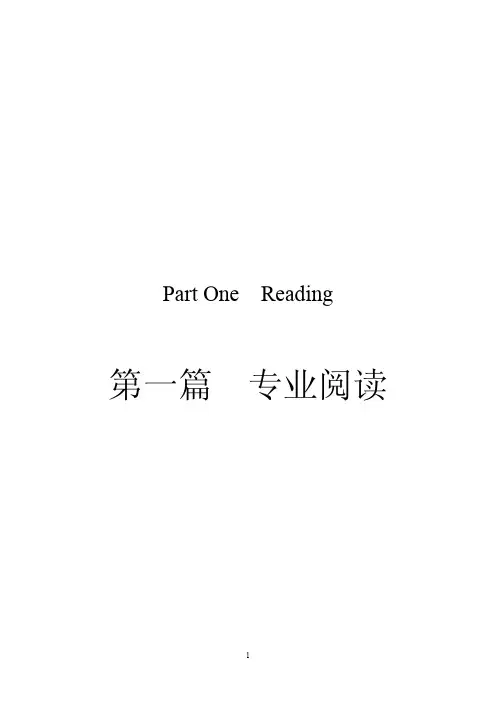
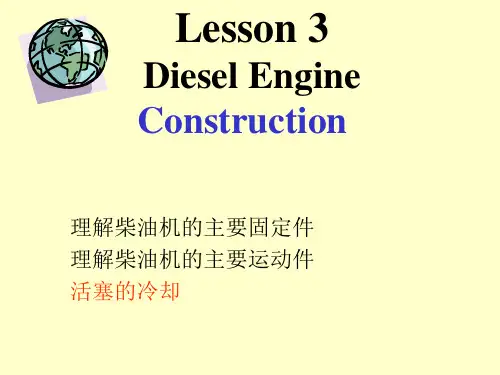
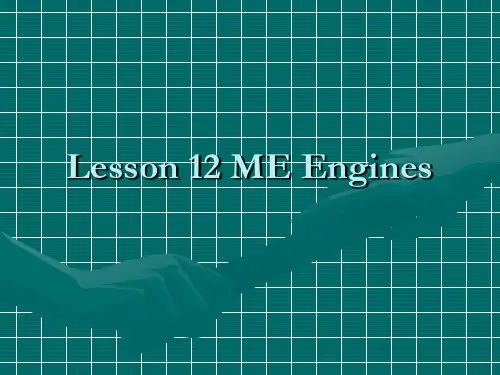
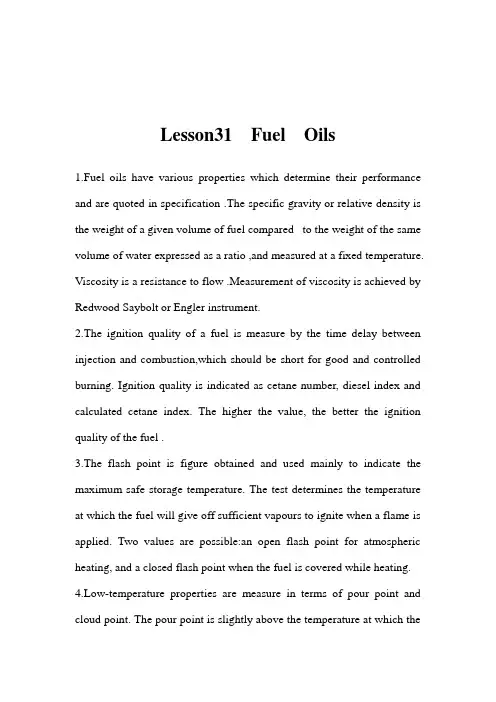
Lesson31 Fuel Oils1.Fuel oils have various properties which determine their performance and are quoted in specification .The specific gravity or relative density is the weight of a given volume of fuel compared to the weight of the same volume of water expressed as a ratio ,and measured at a fixed temperature. Viscosity is a resistance to flow .Measurement of viscosity is achieved by Redwood Saybolt or Engler instrument.2.The ignition quality of a fuel is measure by the time delay between injection and combustion,which should be short for good and controlled burning. Ignition quality is indicated as cetane number, diesel index and calculated cetane index. The higher the value, the better the ignition quality of the fuel .3.The flash point is figure obtained and used mainly to indicate the maximum safe storage temperature. The test determines the temperature at which the fuel will give off sufficient vapours to ignite when a flame is applied. Two values are possible:an open flash point for atmospheric heating, and a closed flash point when the fuel is covered while heating.4.Low-temperature properties are measure in terms of pour point and cloud point. The pour point is slightly above the temperature at which thefuel just flows under its own weight. It is the lowest temperature at which the fuel can be easily handled. At the cloud point waxes will form in the fuel. Below the cloud point temperature, pipe or filter blocking may occur.5.The carbon residue forming property of fuel is usually measured by the Conradson method.Controlled burning of a fuel sample gives a measure of the residual carbon and other remains.6.Sulphur content is of importance since it is considered a cause of engine wear. A maximum limit, expressed as a percentage by weight, is usually included in specifications.7.The calorific value of a fuel is the heat energy released during combustion.Two values are used, the more common being the Higher Calorific Value,which is the heat energy resulting form combustion. The Lower Calorific Value is a measure of the heat energy available and dose not include the heat energy contained in steam produced during combustion but passing away as exhaust. The measurement is obtained form a bomb calorimeter test where a small fuel quantity is burnt under controlled condition.8.The various fuel properties have different effect on performance of the engine and the storage and handling requirement of the system. Blending and the use of various additives will also influence both the engine and the system.9.Viscosity will affect jerk-type injector pumps operation since the liquid fuel is the operation medium. The pump mechanism is lubricated by the fuel which, if it is of low viscosity, will cause wear.10.Cloud point and pour point values are important when considering the lowest system operation temperatures. Wax deposited in filters and fuel lines will cause blockage and may restrict fuel flow to the engine.11.The cetane number or diesel index will determine injection timing and also influence the combustion noise and production of black smoke.The temperature in a fuel system should be progressively increased in order to deliver fuel at the correct viscosity to the injectors or burners. System cleanliness is also very important to reduce wear on the many finely machined parts in essential. Various additives are used to, for instance,remove lacquer from metal surface, reduce wear and prevent rust.。
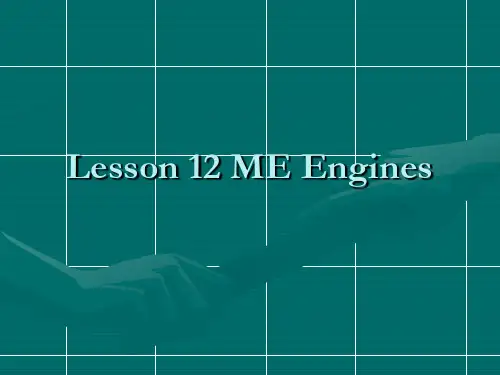
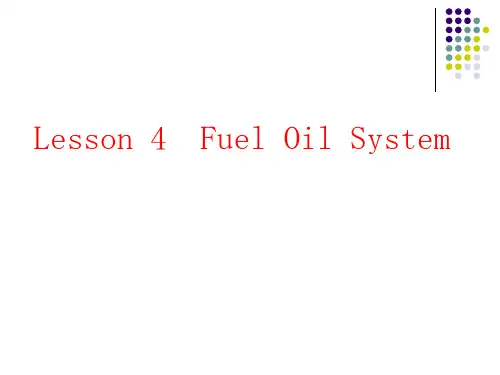
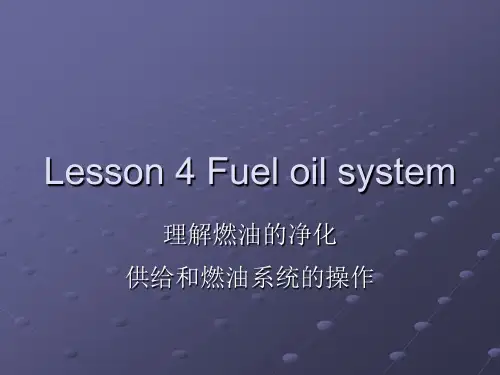
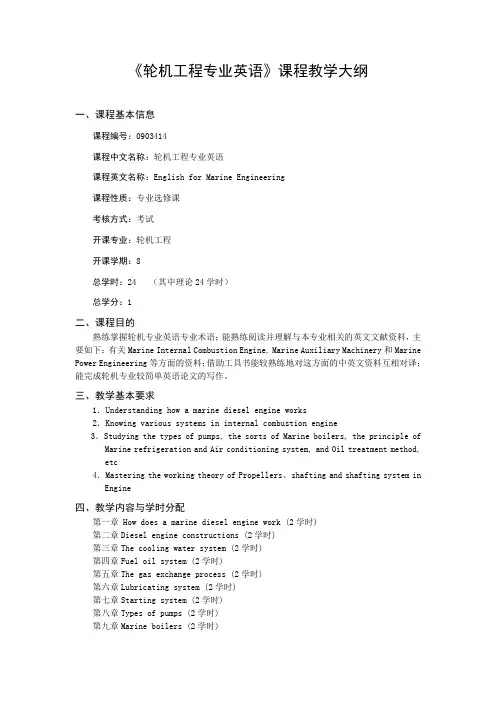
《轮机工程专业英语》课程教学大纲一、课程基本信息课程编号:0903414课程中文名称:轮机工程专业英语课程英文名称:English for Marine Engineering课程性质:专业选修课考核方式:考试开课专业:轮机工程开课学期:8总学时:24 (其中理论24学时)总学分:1二、课程目的熟练掌握轮机专业英语专业术语;能熟练阅读并理解与本专业相关的英文文献资料,主要如下:有关Marine Internal Combustion Engine, Marine Auxiliary Machinery和Marine Power Engineering等方面的资料;借助工具书能较熟练地对这方面的中英文资料互相对译;能完成轮机专业较简单英语论文的写作。
三、教学基本要求1.Understanding how a marine diesel engine works2.Knowing various systems in internal combustion engine3.Studying the types of pumps, the sorts of Marine boilers, the principle of Marine refrigeration and Air conditioning system, and Oil treatment method, etc4.Mastering the working theory of Propellers、shafting and shafting system in Engine四、教学内容与学时分配第一章 How does a marine diesel engine work (2学时)第二章Diesel engine constructions (2学时)第三章The cooling water system (2学时)第四章Fuel oil system (2学时)第五章The gas exchange process (2学时)第六章Lubricating system (2学时)第七章Starting system (2学时)第八章Types of pumps (2学时)第九章Marine boilers (2学时)第十章Steering gear (2学时)第十一章Marine refrigeration (2学时)第十二章Air conditioning system (2学时)五、教学方法及手段采用理论授课方式,课堂上进行互动教学,锻炼学生专业英语的读写和归纳、总结能力。
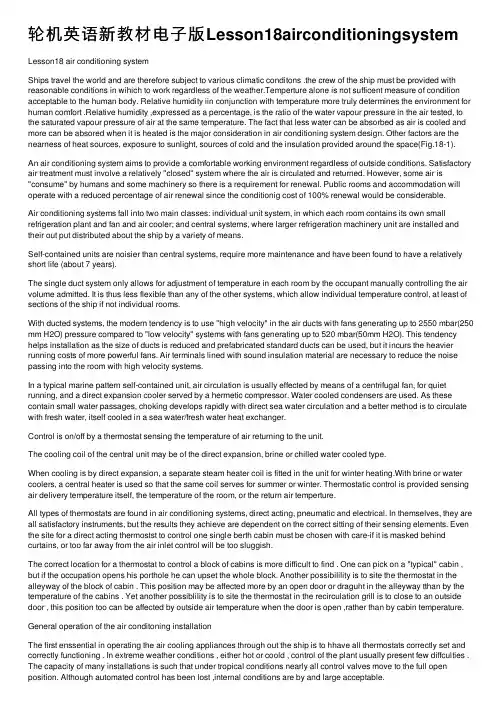
轮机英语新教材电⼦版Lesson18airconditioningsystem Lesson18 air conditioning systemShips travel the world and are therefore subject to various climatic conditons .the crew of the ship must be provided with reasonable conditions in wihich to work regardless of the weather.Temperture alone is not sufficent measure of condition acceptable to the human body. Relative humidity iin conjunction with temperature more truly determines the environment for human comfort .Relative humidity ,expressed as a percentage, is the ratio of the water vapour pressure in the air tested, to the saturated vapour pressure of air at the same temperature. The fact that less water can be absorbed as air is cooled and more can be absored when it is heated is the major consideration in air conditioning system design. Other factors are the nearness of heat sources, exposure to sunlight, sources of cold and the insulation provided around the space(Fig.18-1).An air conditioning system aims to provide a comfortable working environment regardless of outside conditions. Satisfactory air treatment must involve a relatively "closed" system where the air is circulated and returned. However, some air is "consume" by humans and some machinery so there is a requirement for renewal. Public rooms and accommodation will operate with a reduced percentage of air renewal since the conditionig cost of 100% renewal would be considerable.Air conditioning systems fall into two main classes: individual unit system, in which each room contains its own small refrigeration plant and fan and air cooler; and central systems, where larger refrigeration machinery unit are installed and their out put distributed about the ship by a variety of means.Self-contained units are noisier than central systems, require more maintenance and have been found to have a relatively short life (about 7 years).The single duct system only allows for adjustment of temperature in each room by the occupant manually controlling the air volume admitted. It is thus less flexible than any of the other systems, which allow individual temperature control, at least of sections of the ship if not individual rooms.With ducted systems, the modern tendency is to use "high velocity" in the air ducts with fans generating up to 2550 mbar(250 mm H2O) pressure compared to "low velocity" systems with fans generating up to 520 mbar(50mm H2O). This tendency helps installation as the size of ducts is reduced and prefabricated standard ducts can be used, but it incurs the heavier running costs of more powerful fans. Air terminals lined with sound insulation material are necessary to reduce the noise passing into the room with high velocity systems.In a typical marine pattern self-contained unit, air circulation is usually effected by means of a centrifugal fan, for quiet running, and a direct expansion cooler served by a hermetic compressor. Water cooled condensers are used. As these contain small water passages, choking develops rapidly with direct sea water circulation and a better method is to circulate with fresh water, itself cooled in a sea water/fresh water heat exchanger.Control is on/off by a thermostat sensing the temperature of air returning to the unit.The cooling coil of the central unit may be of the direct expansion, brine or chilled water cooled type.When cooling is by direct expansion, a separate steam heater coil is fitted in the unit for winter heating.With brine or water coolers, a central heater is used so that the same coil serves for summer or winter. Thermostatic control is provided sensing air delivery temperature itself, the temperature of the room, or the return air temperture.All types of thermostats are found in air conditioning systems, direct acting, pneumatic and electrical. In themselves, they are all satisfactory instruments, but the results they achieve are dependent on the correct sitting of their sensing elements. Even the site for a direct acting thermostst to control one single berth cabin must be chosen with care-if it is masked behind curtains, or too far away from the air inlet control will be too sluggish.The correct location for a thermostat to control a block of cabins is more difficult to find . One can pick on a "typical" cabin , but if the occupation opens his porthole he can upset the whole block. Another possibilility is to site the thermostat in the alleyway of the block of cabin . This position may be affected more by an open door or draguht in the alleyway tthan by the temperature of the cabins . Yet another possiblility is to site the thermostat in the recirculation grill is to close to an outside door , this position too can be affected by outside air temperature when the door is open ,rather than by cabin temperature. General operation of the air conditoning installationThe first enssential in operating the air cooling appliances through out the ship is to hhave all thermostats correctly set and correctly functioning . In extreme weather conditions , either hot or coold , control of the plant usually present few diffculties . The capacity of many installations is such that under tropical conditions nearly all control valves move to the full open position. Although automated control has been lost ,internal conditions are by and large acceptable.Control diffculties arise in intermediate weather conditions when there is a call for only a small amout of cooling. The worst case is when part of the ship,say inboard cabins against the engine room , require cooling and other parts ,say exposed upper cabins , require warming .For this intermediate condition,thermostats must be correctly set by trial and error. It is found that a uniform setting of say 21°C throughout the ship is not satisfactory ,but slight variations of a few degrees up or down are needed to suit particular regions of the ship. Unfortunately, these variations in thermostat setting are not always the same for the cooling and heating condition and frequent resetting may be needed for a ship repeatedly passing from cold to warm weather.The control problem is eased if the chilled brine (or water) of systems using chilled liquid circulation is held at about 13°C in the intermediate weather conditions and lowered progressively to about 5°C as tropical weather conditions are approached. When air cooling is in use it is good practice to keep all portholes, windows and doors shut. On passengerships, some public announcement requesting that this be done is worthwhile.A wise precaution for an engineer to take is to go through accommodation and public rooms periodically recording wet and dry bulb temperature. Keeping a log of these reading then serves to identify any malfunctioning of the installation as soon as it arises.The quantity of cooled air delivered by an air conditioning unit should bablance the sum of the quantity of the air recirculated to the quantity mechanically exhausted. The correct bablance between supply and exhaust fans should be checked periodically. Even with filters fitted ducts can become partially blocked can fan performance can fall off to upset the bablance.On older ships, temperature maintenance can be made easier by increasing the ratio of recirculated to fresh air. Most air conditioning units have dampers for adjusting this ratio and the effect of these can be extended after they have reached, full travel by partially blocking fresh air inlets. Care must be taken not to reduce the fresh air so that stuffiness or smells arise.Cleaning or renewal of filters is necessary at baout 3-monthly intervals, the time varying according to location on the ship. Disposable filters can be vacuum-cleaned so that in fact two or three "lives" are obtained before they need to be thrown away.In addition to normal mechanical attention, such as lubrication of bearings, and adjustment of fan belts and cleaning of motors, careful greasing of linkages of automatic controls is necessary.Cooled air ducts should be examined to see that the insulation vapour seal remains in good order. If a plastic film: vapour seal becomes damsged, condensation forms within the film. As well as making the insulation wet and ineffective, the condensation may become serious enough to cause drips and damp parches on ceilings.VentilationVentilation is the provision of a supply of fresh untreated air through a space. Natural ventilation occurs when changes in temperature or air density cause circulation in the space. Mechanical or forced ventilation uses fans for a positive movement of large quantities of air (Fig. 18-2).Natural ventilation is used for some small workshops and stores but is impractical for working areas where machinery is present or a number of people are employed.Forced ventilation may be used in cargo spaces where the movement of air removes moisture or avoids condensation, removes odors or gases,etc.The machinery space presents another area which requires ventilation. As a result of itslarge size and the fact that large volumes of air are consumed a treatment plant would be extremely costly to run. Ventilation is therefore provided the sufficient quantities for machinery air consumption and also to effect cooling. Several axial flow fans provide air through ducting to the various working platforms. The hot air rises in the centre and leaves through louvers or openings, usually in the funnel. The machinery control room, as a separate space, may well be arranged for air conditioning with an individual unit which draws air through trucking from the outside and exhausts back to the atmosphere.Notes1. Air conditioning systems fall into two main classes: individual unit system, in which each room contains its own small refrigeration plant and fan and air cooler; and central systems, where larger refrigeration machinery unit are installed and their out put distributed about the ship by a variety of means.空调系统分为两⼤类,独⽴空调系统和中央空调系统。
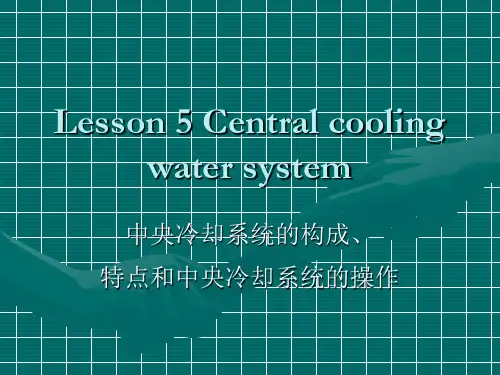
《轮机英语》课程标准一、课程信息考试考查□是是二、课程性质与作用《轮机英语》是轮机工程技术专业的一门重要的专业技术课程,旨在为学生掌握必需的专业语言技能、适应日后工作奠定坚实的理论和实践基础。
通过本课程的学习,使学生初步具备五个方面的能力:船舶主推进装置专业语言技能、船舶辅机专业语言技能;船舶电气及自动化专业语言技能;船舶管理及国际公约语言技能。
结合课程教学,培养学生的语言能力以及学习新技术的能力。
本课程在培养高素质技能型轮机工程技术人才方面起着综合提高的作用,对学生的职业能力培养和职业素养的养成起着支撑或促进作用。
本门课程作为船舶轮机员(三管轮)的适任考证课程,其前导课程是《船舶柴油机》、《船舶辅机》、《船舶电气及自动化》、《船舶管理》等专业课程。
表2 课程功能定位分析通过本课程的学习,能使学生进一步增强民族复兴责任感和自豪感,增强爱国、爱党的意识;树立社会主义核心价值观;弘扬精益求精的工匠精神,增强对国家海洋强国战略的使命感;为我国的航运强国以及一带一路的战略实施尽到自己的职责。
并养成较强的集体意识和团队合作精神,能够进行有效的人际沟通和交流,具有较强的专业创新能力和素养,为日后适任工作岗位、进一步学习和研究打下良好的基础。
四、课程目标本课程通过大量远洋、海运公司的第一线专业调研和专家、学者和教师组成的专家队伍论证,形成从专业定位、课程内容组织、教学活动设计到课程体系构建链条。
即:贯彻以职业生涯发展为目标——明确专业定位,以职业能力为依据——组织课程内容,以船舶机舱设备自动控制的真实场景为载体——设计教学活动,以职业技能鉴定为参照——强化技能训练,以工作任务为线索——构建基于工作过程的课程体系。
本课程的任务是在公共英语和轮机基础英语教学的基础上,巩固、扩大学生的英语基础,培养学生阅读和翻译简明轮机英语出版物和有关技术资料的能力和书写与本专业有关的简短文书的能力,使学生能以英语为工具,进行业务交流,在理论上达到STCW公约中规定的管理级船员应具备的英语水平,在实践技能上达到操作级船员应具备的英语水平。
аæ½Ì²ÄÌí¼ÓÄÚÈÝA1£®When a ship in loaded condition floats at arbitrary water line, its displacement is ___to the relevant mass of water displaced by the ship.A. equalB. largerC. smallerD. equivalentB2£®The displacement of a ship is ___ to the total weight, all told, of the relevant loaded ship.A. largerB. equalC. smallerD. equivalentB3. Which one is true?A. Two main areas of skill are involved in the construction of ship.B. There are distinct divisions in responsibilities between naval architects and marine engineers.C. Each ship will assume varying proportions according to its type.D. Ships can be divided into different categories from different perspectives. D4. Why a gearbox is needed in a ship driven by a medium-speed diesel engine?A. To reduce the main engine speed.B. To increase the main engine speed.C. To govern the main engine speed.D. To fix the propeller shaft.B5. A propeller, in order to operate efficiently, must rotate at a relatively ___ speed.A. highB. lowC. fastD. lowlyD6. Ina diesel engine, ________ offers the heat energy directly; ________ works as working medium and changes the heat energy to mechanical energy.A. the burning of the fuel; medium shaftB. fuel spray; fresh airC. fuel; fuel sprayD. the burning of the fuel, the burned gas mixture B7. In a diesel engine, ________ works as working medium and changes the heat energy to mechanical energy, ___________ changes the reciprocating movement to rotary moment.A. fuel spray; the burning of the fuelB. the burned gas mixture; connecting rodC. medium shaft; crankshaftD. the burned gas mixture; piston rodD8. One of the differences between a two-stroke engine and a four-stroke engine is, _________.A. a two-stroke engine works without exhaust operationB. a two-stroke engine works without compression strokeC. a two-stroke engine works without expansion strokeD. a two-stroke engine works without suction operationD9. One of the differences between a two-stroke engine and a four-stroke engine is, _________.A. a two-stroke engine can¡¯t work without cylindersB. a two-stroke engine can¡¯t work without pistonC. a two-stroke engine can¡¯t work without crankshaftD. a two-stroke engine can¡¯t work without a blowerC10. In a diesel engine, with the fuel is injected into the cylinder, ________________.A. the piston is just coming upward from the bottom dead center.B. the piston has moved about one-fifth of the up.C. the piston has moved most of the way up and almost reached the TDC.D. the piston has just past the TDC.B11. ___________ is the main reason that reduces the power advantage of a two-stoke engine over a same size four-stroke one to about _________.A. Inefficient scavenging; twiceB. Inefficient scavenging; 1.8 timesC. Fewer strokes in a circle; twiceD. Fewer strokes in a circle; 1.8 timesA12. If the engine is naturally aspirated, or is a small high-speed type with a centrifugal turbocharger, the period of valve overlap, i.e. when both valves are ____, will be _____, and the exhaust valve will close some 10¡ã ______ top dead canter.A. open; short; afterB. closed; short; afterC. open; long; before D; closed; long; beforeA13. In a two-stroke engine, there are always a series of openings known as ________, and in some circumstances, there are also openings known as _________, in the part of the cylinder liner inside the scavenging air box.A. scavenging air ports; exhaust portsB. inlet ports; scavenging air ports;C. scavenging air ports; inlet portsD. exhaust ports; inlet potsA14. In some type of two-stroke engines, besides some small holes for ______, starting valve, safety valve, indicator cock, and so on, there is a large central opening in each cylinder cover for mounting the _________.A. fuel valves; exhaust valveB. exhaust valve; inlet valveC. fuel valves; inlet valveD. exhaust valve; fuel valveC15. In a two-stroke engine, the piston consists of a lower part, which in named as ______ and usually made of _______, and a upper part, which is referred to as ______ and made of ______.A. low-half, cast iron; top-half, heat-resistant steelB. low-half, aluminum; top-half, stainless steelC. piston skirt; cast iron; piston crown; heat-resistant steelD. piston skirt; aluminum; piston crown; stainless steelB16. In order to keep the oil film on the cylinder liner during the running-in period, the piston ring are slightly rounded __________________.A. on both the external and internal top edgesB. on both the external top and bottom edgesC. on both the external and internal bottom edgesD. on all the four edgesD17. In order to control thermal stresses, some types of modern engines use piston with _________.A. heavy wall and intensive coolingB. heavy wall and no coolingC. thin wall and no coolingD. thin wall and intensive coolingA18. In order to improve the working conditions of the crosshead bearing, the bearing pressure is made ______ and the peripheral speed is made ______ in later designs.A. smaller, higherB. higher, smallerC. smaller, smallerD. higher, higherB19. When the heavy fuel oil is heated to achieve the viscosity of 10-15 cSt, ______ may occur. To avoid this, a _________ system is used in most occasions.A. boiling and cavitations; low temperatureB. boiling and cavitations; pressurizedC. leaking and boiling; low temperatureD. leaking and boiling; pressurized D20. The fuel from the bunker tanks must be treated by ______ before entering the service tanks, from where the fuel enters _________.A. centrifugal separators; the engine cylinderB. oily water separators; the engine cylinderC. oily water separators; the fuel supply systemD. centrifuges; the fuel supply systemA21. A full-flow 50¦Ìm filter is installed _________, so the injection system components on the main engine are safeguarded.A. as close to the main engine as possibleB. as close to the main pump as possibleC. just before the fuel valveD. just before the booster pumpB22. The booster pump, which supplies diesel oil to _________, should have a possibility of being powered by compressed air or by emergency power.A. the main enginesB. the auxiliary enginesC. the emergency generator engineD. the auxiliary engines and the main engine(s)D23. ______is harmful for fuel pumps, fuel valves, cylinder liner, exhaust valve seats, and the turbocharger blades as well.A. Bed combustion of the fuelB. Bed atomization of the fuelC. Liquid contaminantsD. Solid contaminantsB24. As an alternative to the conventional seawater cooling system, _________ is based on _______ principles about cooler locations, flow control and preheating, but with a central cooler and one additional set of pumps.A. the central cooling system, differentB. the central cooling system, the sameC. the opening cooling system, differentD. the opening cooling system, the sameD25. An alarm device inserted between the deaerating tank and the expansion tank can notify the on-watching crew that _____________.A. the expansion tank in lack of waterB. the expansion tank is over flowingC. there is something wrong with cooling systemD. there is something wrong with the engineD26. The ___________ cooling system needs least maintenance work for __________ in this kind of system.A. open, the minimum componentsB. open, the high cooling efficiencyC. central, there more coolers and a extra set of pumpsD. central, there is only one component contacts seawaterB27. About the jacket water, that of the auxiliary engines usually is circulated by_________ pumps,And the main engine usually___________.A.an engine-driven, as wellB.an engine-driven, has an independent pumpC.an independent, ad wellD.an independent, has an engine-driven pumpB28.In order to maintain a constant outlet water temperature of 80¡ª85 from the engine ,aThree ¨Cway valve is installed___________.A.at the jacket cooler outlet to control the flux through the engineB.at the jacket cooler outlet to control the flux through the coolerC.at the engine outlet to control the flux through the engineD.at the engine inlet t to control the flux through the engineC29.In modern installations ,the main engine and the standby auxiliary engines___________A. can be started at low temperature and are free from preheatingB .usually are preheated by steam before being startedC. are kept at a constant temperature and free from preheatingD .are kept at a low temperature to save engineC30.A marine diesel engine is started by_____________A. supplying high pressure oil into a hydraulic motorB .supplying high temperature air into the cylinderC .supplying high pressure air into the cylinderD .electrical ignitingC31.The staring air system of an engine on board usually has interlocks in to ____________A .ensure a successful shutting down at emergency conditionsB .ensure a successful starting at emergency conditionsC .prevent the engine from starting at some abnormal condition sD .prevent the engine from starting at emergency condition sA32.In the starting system, the automatic valve is controlled by ________,and the cylinder start valves are controlled by_________.A. pilot air; pilot airB. handle; solenoidC. handle, pilot air coming through the distributorD. solenoid; pilot air coming through the distributorB33.The starting air entering the cylinder begins when the piston _________.A. has nearly come to TDCB. has just past the TDCC. has nearly come to BDCD. has just past the BDCC34. When starting an engine, the compressed air enters the cylinder when the corresponding piston is in position of its_________.A. suction strokeB. compression strokeC. power strokeD. exhaust strokeA35. When an engine is starting and has got a sufficiently high speed, say about 20 rpm,_______.A. the starting air supply is cut off and fuel is injected into the cylindersB. the fuel feeding is cut off and the turning gear is put inC. the starting air supply is cut off and the turning gear is taken outD the electric blower is shut down and fuel is injected into the cylindersB36. The air distributor is conventionally drive by and distributes into each cylinder by sequence.A. camshafr; fresh airB. camshafr; starting airC. electronic motor which is controlled by a computer; fresh airD. electronic motor which is controlled by a computer; starting airD37. The following options are all the functions of lubricating oil except________.A. removing heat and depositsB. neutralizing acidic productsC. lubricatingD. improving combustion cfficiencyC38. ______diesel engines generally have two systems of lubrication:a total loss system feeding_____and a circulating system lubricating the running gear and cooling the pistons.A. Large crosshead type , crossheadsB. High speed , the cylindersC. Large crosshead type , cylindersD. Four-stroke, pistons and cylinders C39. In soom diesel engine designs , the injection of cylinder oil is timed to impinge when the pistion|_____and only impinge on______.A. is coming upward , cylinder ring beltB. is going downward, piston ring beltC. is coming upward, piston ring beltD. is going downward,cylinder ring beltC40. Large crosshead type engine generally has two lubrication systems, a function performed only by cylinder oil system is ______.A. lubricatingB. coolingC. sealingD. cleaningB41. Large crosshead type engine generally has two lubrication systems, a function performed only by crankcase oil system is_______.A. lubricatingB. coolingC. cleaningD. neutralizingB42. ¡°The use of deposits in the piston crown which in turn results in a considerable reduction in heat transfer with subsequent overheating and thermal cracking.¡±According to this sentence we can know that the principle reason of the overheating and thermal cracking is _______.A. the use of a poor quality oilB. the deterioration of its propertiesC. the formation of depositsD. the reduction in heat transfer ability C43. Gas exchange. Is a basic part of the cycle of an internal combustion engine. Is ______.A. the supply of normal air and removal of compressed airB. the supply of fuel oil and combustion of the atomized oilC. the supply of fresh air and removal of exhaust gasesD. the supply of fresh air and removal of extra heatD44. ¡°This increase in charge air densety is accomplished on most modern diesel enginetypes by use of exhaust gas turbo-charging,in which a turbine wheel driven by exhaust from the engine is rigidly coupled to a centrifugal type air compressor.¡±According to this sentence,we can know that ______increases charge air density ,_____drives the compressor directly.A. a modern diesel engine, a turbine wheelB. a modern diesel engine . exhaust gasesC. a compressor , an exhaust fas turbochargerD. a compressor ,a turbine wheelA45. When the air charge contacts with the cylinders and pistons and mixes with the residual gases ,it will_____.A. increase in temperatureB. lose its energy partlyC. expand and do workD. begin to be compressedC46. Usually we take the cooling effect of the air flown through the cylinder during the wverlap period as ________.A. inevitableB. harmfulC. helpfulD. unacceptableC47. In slow speed two-stroke engines,the fresh air entering begins when______and stops as_____.A. the inlet port is opened by the up coming piston;the port is closed by the down going pistonB. the inlet valve is opened by the down going piston ;the inlet valve is closedC. the inlet port is opened by the down going piston ;the port is closed by the up coming pistonD. the inlet valve is openedC48. The____is employed to warm up a large diesel engine before its starting. A. Hot air B. Hot boiler water C. Cylinder water D. hot seawaterD49. Which one of the followings may not be checked before engine sarting?A. tank levelB. Various filtersC. drainsD. seawater temperature A50. When the direction handle of telegraph is moved,the relative position of camshat and crankshaft will be_____.A. changed accordinglyB. unchangedC. positioned aheadD. positioned asternA51. Which of the followings will affect the spray of fuel oil?A. coke depositsB. cylinder water temperatureC. asphalt in fuel oilD. lub oilB52. Which one of the following may contribute to the forming of coke around the nozzle of fuel valve ?A, too much water in fuel oil B. too much asphalt in fuel oilC. larger nozzle holesD. more nozzle holes inlet valveis closedA53. The transmission system transmitting power forom the engine to the propeller is composed of shafts , bearings, and _____.A. propellerB. flying wheelC. main engineD. crankshaftB54. The thrust from the propeller to the hull of the ship is transferred by ____.A. tie rodB. thrust blockC. bedplate of main engineD. frame of mainengineD55. ______is used to prevent the entry of sea water to the machinery space.A. A special sealing glandB. propellerC. TailshaftD. Sterntube bearingA56. Oil pressure in the lubrication system is _____than the static tea water head to ensure that sea water cannot enter the sterntube in the event of seal falure A. higher B. lower C. very higher D. very lowerB57. The propeller consists of a _____with several blades of helicoidal form attached to it.A. shaftB. bossC. wheelD. leverB58. The difference between Fixed pitch propeller{FPP}and Controllable pitch propeller{CPP}is in thatA. for FP , once fitted,the position of the blades can also be3 changed in operationB. for CP, once fitted ,the position of the blades can also be changed in operationC. the CP type has a relatively smaller hub compared with the FP propellersD. the FP type has a relatively larger hub compared with the cp propellersA59. In conventional systems,the injection pressure_______,while it¡¯s_____in common rail diesel engine.A. fluctuates with the engines speed to extent,independent of engine speedB. keeps constant at all engine speed,dependent on the engine speed to some extentC. keeps constant at all engine speed,independent of the engine speedD. is decided by the engine speed,constant at all engine speedA60. In common rail engines,the fuel is________before is injectsed into the cylinders.A.stored in a common fuel lineB.pumped by the injection pumpB.at low pressure D.already atomizedC61. Ina common rail engine, the fuel is injected into cylinders________.A. by injection pumpsB.at a time decided by the injection pump timingC.by a signal opening the magnetic valvesD.at a time decided by the cam directlyA62. _________uses one or tow high pressure pumps for all the cylinders with one more Standby,while______have aseparate high-pressure pump for each cylinder.A.A common rail engine, conventional engineB.A conventional engine, common rail enginesC.A marine diesel engine, most other enginesD.A two-stroke engine, four-stroke enginesD63. A common rail engine has only one or tow high pressure pumps in operation at the sametime, and the injection into each cylinder_______.A.can¡¯t be controlled very preciselyB.can¡¯t be controlled as flexibly as the separate pump systemC.can be controlled as flexibly as the separate pump systemD.can be controlled more precisely and flexiblyB64. The common rail engines show great advantages in combustion sepecially ______.A. at high speed and full loadB. at low speed and part loadC. when heavy fuel oil is used at seaD. when the ships run distanceA65. To meet the market requirements, a marine diesel engine should not be of________.A. big sizeB. fuel economyC. low speedD. high powerD66. The main purpose of changing main engine to electronic controlled is not to________.A. control fuel injection time more preciselyB. control fuel injection rate more preciselyC. meet the environmental requirementsD. meet high engine speed requirementsA67. If a cam-controlled engine has a normal injection pressure at rate speed, the injectionpressure will be________ at slow speed.A. a little lowerB. a little higherC. too lowD. exactly the sameD68. If a camshaft-less engine has a normal injection pressure at rated speed, the injectionpressure will be _______at low speed.A. too lowB. a little lowerC. a little higherD. exactly the sameC69. _______is not a feature of the electronic controlled engines.A. Lower fuel consumptionB. Better balanced cylinder powerC. A shorter overhaul periodD. Less smoke emissionA70. The mechanical exhaust valve operation system is replaced by _______ in an electroniccontrolled ME engine.A.a system with a Hydraulic Power Supply (HPS) unitB.a system with roller guides for exhaust valvesC.a system with an electronically controlled Alpha LubricatorD.a system with directly powered by electric motorA71. ______ are mounted in pairs to protect the boiler against overpressure.A. Safety valvesB. Water tubesC. Steam stop valvesD. Blow down valvesB72. When steam is being raised on a boiler, the water level will normally __________.A. drop as the boiler warms upB. rise as the boiler warms upC. remain unchanged until the boiler is hot enoughD. rise and fall with the steam demandD73. The donkey boiler may be given a bottom blow ________.A. to raise water levelB. only while making steamC. to remove scumD. when fire is securedC74. Impurities from the boiler water surface can be removed though the _______.A. safety valveB. blow down valveC. scum valveD. feed check valveC75. The exhaust boilers are used to recover some of ________carried in the exhaust gas from themain engine.A. waterB. oilC. heatD. steamA76. The defective place in the furnace should be _________ with fire bricks.A. pavedB. cleanedC. weldedD. dismantledC77. The safety valves are mounted in pairs to ___________the boiler against overpressure.A. useB. releaseC. protectD. effectC78. The valve that prevents water from backing out of the boiler into the feedline is the _______.A. bottom-blow valveB. skin valveC. feed-check valveD. feed-stop valveD79. The boiler feed water check valves are located on the ________.A. feed pump suction lineB. hot wellC. shell of the feed heaterD. feed lines the boilerB80. If in doudt as to the true water level when a boiler is being Oil-fired, you should _______.A. take no measuresB. extinguish the fire as soon as possibleC. feed water to the boilerD. open the blow down valveA81. The boiler feed pump discharge pressure is higher than the steam dram pressure to _______.A. ensure feed water flow into the boilerB. keep the steam drum pressure highC. prevent water hammer in the feed lineD. help the feed water flash to steam C82. Safety valves in a boiler vent to the ________.A. Fuel tankB. bilgeC. atmosphereD. auxiliary exhaust lineD83. ________Will be used to blow away the combustion products from the tube surfaces.A. The blow down valveB. The scum valveC. the ah¡¯relase cockD. The soot-blowerC84. Soot blowers should be used in proper sequence so that _______.A. excess stresses will not be set up in the boilerB. the decks will not be covered with sootC. the soot will be swept toward the uptakesD. there will not be a loss of steam pressureC85. What is the first thing you would check on taking over a watch?A. the bilgesB. the waterC. the periscopeD. the oil pressureD86. One of the main purposes of refractories in a boiler furnace is to _________.A. help preheat the air for the furnacesB. help preheat the feedwaterC. protect economizer from excessive heatD. prevent excessive furnace heat losses C87. the pump has a constant stroke and the amount of fuel delivered is regulated byrotating _______ which has a specially arranged helical groove cut into it.A. the pump cylinderB. the pump camC. the pump plungerD. the pump milerD89. The pumps press oil into the cross-head bearing gap when the load on the shell is at itslowest. What is the meaning of ¡°its¡± in the sentence above?´ð°¸DB90. A vane pump belongs to _______according to its working principle.A. reciprocating pumpB. positive displacement pumpC. centrifugalD. centripetal pumpA91.Through a _______pump ,the liquid is transferred from the suction to the discharge by the mechanical variation of the volume of a chamber or chambersA. positive displacementB. ejectorC .centrifugal D. air compressorC92.The gear and screw pumps are classified as_______.A. variable stroke pumpsB. multistage pumpsC. positive displancement pumpsD. triple-ported pumpsB93.A gear pump belongs to ______according to its working principle.A. reciprocating pumpsB. positive displancement pumpsC. centrifual pumpsD. centripetal pumpsB94.A Screw pump belong to______according to its working principle.A. reciprocating pumps B .positive displancement pumpsC. centrifual pumpsD. centripetal pumpsA95.When the heat load begins to increase,the needle valve of an expansion valve will A. move in an opening direction B. move in a closing directionC. either open or close D .not move at allB96.When the refrigeration demand is small,_____________.A .the expansion valve will move toward the wide open positionB. the expansion valve will move toward the closing positionC .the feeler bulb will conveys the high temperatureD. the superheat degree will raise.D97.The thermostatic valve has a throttling action,that is to say the valve can_______.A. stop the refrigent from flowingB. force the refrigerant to flowC. cause the refrigerant pressure to rise D .cause the refrigerant pressure to fall. A98.The thermal expansion valve responds to the_______.A .amount of superheat in the vapor leaving the coilB. amount of superheat in the liquidC. temperature in the evaporator coilD. pressure in the evaporator coilB99.The bulb for the thermal expansion valve is located______.A. in the middle of evaporator coilsB. near the evaporator coil outletC. near the evaporator coil inletD. on the bottlom row of evaporator coilsB100.If the compressorruns continually,the cause might be the_____.A .high-pressure cutout switch is jammed openB .low-pressure switch is jammed shutC. thermal bulb is nt operating properlyD. scale trap is cloggedB101.The solenoid valve can be typed as a_______A .thermal valve B. magnetic stop valveC. bellows valve D .bimetallic valveB102.In term of pressure and temperature tefrigerant in the compressor,what,happens to the primary?________.A .its pressure and temperature are both loweredB .its pressure and temperature are both raisedC. its pressure is lowered and its temperature is raisedD. its pressure is raised and its temperature is loweredB103.What is the purpose of sub cooling R-12in the condenser?_______.A. to increase the system efficiency by sensible heat transferB. to stop the liquid from flashingC. to reduce the load on the compressorD. to remove latent heat of vaporization and the suction piping transferA104.The purpose of the purge valve at the top of the condenser in a refrigerating system is to_____.A .remove any air that may accumulate in the sustemB. take out unpleasant fumes from the refrigerantC. vent off excess refrigerant in an emergencyD. permit opening the refrigerating system for cleaning and inspectingB105.The device used for low-pressure control and high-pressure cutout on a compressor is called a_______.A. cutoutB. pressure controllerC .controller switchD .cutout switchA106.Where are the zinc plates located?__________.A .saltwater side of the condenser B. refrigerant side of the condenser C .in the evaporater coil D. vacuun reducing valveC107.Air or noncondensable gas is removed from a refrigeration system by a_________.A. separating chamberB.system of bafflesC .purge valve D. vacuum reducing valveC108.The compressor suction line conveys the refrigerant vapor fronm_______.A .condenser to evaporator B. compressor to condenserC .evaporator to compressor D. receiver to compressorC109.If the temperature in the icebox is too high,the trouble could be_______. A. a clogged scale trap B .are in the systemC. automatic controls not functioning properlyD. insufficient cooling water to the condenserC110. If no gaskets are used in the piping joints of a Freon system,the joints must be_____.A. finished joints B welded jointsC. ground jointsD. soldered jointsA111. When adding oil to a F reon system one must be sure that______.A. all air is removed from the pump and fittingsB. there is not too high a suction pressureC. the discharge pressure is not too highD. the condenser is shutdown。